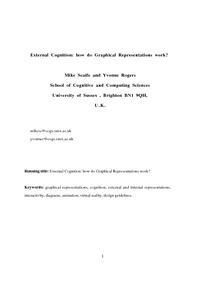 Diese Seite wurde seit 2 Jahren inhaltlich nicht mehr aktualisiert.
Unter Umständen ist sie nicht mehr aktuell.
Diese Seite wurde seit 2 Jahren inhaltlich nicht mehr aktualisiert.
Unter Umständen ist sie nicht mehr aktuell.
 Zusammenfassungen
Zusammenfassungen
Advances in graphical technology have now made it possible for us to interact with
information in innovative ways, most notably by exploring multimedia environments and by
manipulating 3-D virtual worlds. Many benefits have been claimed for this new kind of
interactivity, a general assumption being that learning and cognitive processing are
facilitated. We point out, however, that little is known about the cognitive value of any
graphical representations, be they good old-fashioned (e.g. diagrams) or more advanced
(e.g. animations, multimedia, virtual reality). In our paper, we critique the disparate
literature on graphical representations, focussing on four representative studies. Our
analysis reveals a fragmented and poorly understood account of how graphical
representations work, exposing a number of assumptions and fallacies. As an alternative we
propose a new agenda for graphical representation research. This builds on the nascent
theoretical approach within cognitive science that analyses the role played by external
representations in relation to internal mental ones. We outline some of the central properties
of this relationship that are necessary for the processing of graphical representations.
Finally, we consider how this analysis can inform the selection and design of both
traditional and advanced form of graphical technology.
Von Yvonne Rogers, Myke Scaife  im Text External Cognition (1996)
im Text External Cognition (1996)  Scaife and Rogers review in this article literature on the use of graphical representations in educational environments. The authors argue that despite the vast body of empirical studies in the field little is known about why and how graphics facilitate learning.
Scaife and Rogers review in this article literature on the use of graphical representations in educational environments. The authors argue that despite the vast body of empirical studies in the field little is known about why and how graphics facilitate learning.
The authors have found many shortcomings of empirical studies on graphical representation: assumptions merely based on intuition, lack of integration of theoretical concepts, non-systematic analyses. They distinguish between static diagrams, animations and virtual realities. Static diagrams often depend on prior knowledge about conventions and icons, e.g. diagrams of electronic circuits use a very specific notation. Animations tend to arrest the learners’ attention and thus distract them from verbal explanations. Virtual reality represents the real-world in a very realistic way but often lacks natural interactivity. Moving real-world objects is fairly different from moving an object using a joystick.
To ameliorate the situation the authors propose an analytic framework consisting of three characteristics of graphical representations:
- computational offloading: graphics reduce the learners’ cognitive load, the "knowledge in the world" needs not to be memorized by the learner,
- re-representation: graphics represent abstract structures in a way that is easier to comprehend, and
- graphical constraining: graphics constrain the number of options in problem-solving tasks.
 Dieser Text erwähnt ...
Dieser Text erwähnt ...
 Personen KB IB clear | Donald A. Norman | ||||||||||||||||||
 Fragen KB IB clear | Helfen Hypertextstrukturen beim Lernen? | ||||||||||||||||||
 Begriffe KB IB clear | computational offloading
, Informationinformation
,  information design information design information design
, information design
,  Virtual Reality Virtual Reality virtual reality
, Virtualitätvirtuality
, virtual reality
, Virtualitätvirtuality
,  Visualisierung Visualisierung visualization visualization
| ||||||||||||||||||
 Bücher |
|
 Tagcloud
Tagcloud
 Zitationsgraph (Beta-Test mit vis.js)
Zitationsgraph (Beta-Test mit vis.js)
 Volltext dieses Dokuments
Volltext dieses Dokuments
 |  External Cognition: Artikel als Volltext ( External Cognition: Artikel als Volltext ( : :  , 133 kByte; , 133 kByte;  : :  Link unterbrochen? Letzte Überprüfung: 2020-11-28 Letzte erfolgreiche Überprüfung: 2013-05-28) Link unterbrochen? Letzte Überprüfung: 2020-11-28 Letzte erfolgreiche Überprüfung: 2013-05-28) |
 Anderswo suchen
Anderswo suchen 
 Beat und dieser Text
Beat und dieser Text
Beat war Co-Leiter des ICT-Kompetenzzentrums TOP während er Dieser Text ins Biblionetz aufgenommen hat. Die bisher letzte Bearbeitung erfolgte während seiner Zeit am Institut für Medien und Schule. Beat besitzt kein physisches, aber ein digitales Exemplar. Eine digitale Version ist auf dem Internet verfügbar (s.o.). Aufgrund der wenigen Einträge im Biblionetz scheint er es nicht wirklich gelesen zu haben. Es gibt bisher auch nur wenige Objekte im Biblionetz, die dieses Werk zitieren.









 Biblionetz-History
Biblionetz-History